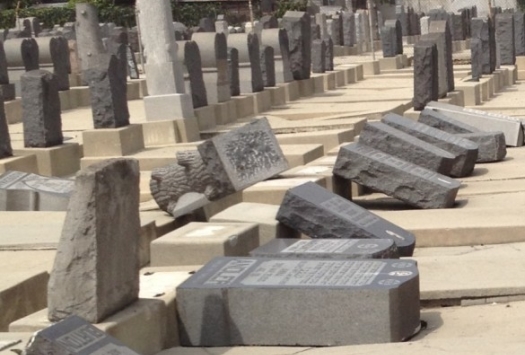
Saving the Face of Mount Zion Cemetery
It’s a spectacle that could frighten just about anyone.
Cemeteries can be uncomfortable places, but this one—the Mount Zion Cemetery in East Los Angeles, Calif., and its dilapidated state—brought a rabbi to tears.
Rabbi Moshe Greenwald, director of Chabad of Downtown Los Angeles, said he cried the first time he witnessed the conditions there. “Walking through a neglected cemetery and seeing whole rows of headstones toppled over is a very jarring sight,” he said, sighing. “There have been many years of neglect. Mount Zion was essentially abandoned.”
The grave markers are concrete slabs that weigh as much as 2,000 pounds; they are impossible for a human being to lift. Nevertheless, they can crack and weaken over time or during an earthquake, explained Greenwald, and if not repaired, the cracks grow, causing permanent damage. Many of the concrete ledgers on top of the graves have become loose and already fallen.
“Of the 6,700 graves,” he said, “most are still standing, but about 100 are presently cracked and in need of some sort of repair to prevent them from toppling over.”
Some 350 headstones have tumbled to the ground within the last 20 years, according to Greenwald. Damage from seismic activity—coupled with vandalism, not unusual in Jewish cemeteries—has turned Mount Zion into an alarming sight. In addition to the cracked and toppled graves, gaping holes in the concrete can be seen. Graffiti abounds. Rounded enameled photographs of the deceased have been pried off the graves. They litter the ground; bullet holes attest to the fact that they are often used for target practice.
Parts of the cemetery were headed toward complete deterioration until a recent wave of media attention, including articles in the local Jewish press and the Los Angeles Times, began alerting the public to the grim conditions.
Greenwald has assumed the responsibility of initiating a restoration project, disseminating information about the damages that have been assessed, as well as the calculation of necessary repairs.
In May, he accompanied others on an informal tour of the cemetery. With him was Californian entrepreneur and philanthropist Shlomo Rechnitz, who apparently wrote a check that very day for $250,000 to go toward repairs.
The Jewish Journal of Greater Los Angeles wrote that Rechnitz said “the situation there is nothing short of deplorable. We live in a city that features and showcases so many beautiful, lavish, prestigious homes, and when it comes to our dead, we are centuries behind Europe.” He was referring to extensive efforts in Europe to restore and maintain Jewish cemeteries, many of which were desecrated during the Holocaust.
Rechnitz’s grandfather, Henry Rechnitz, is buried in the adjacent Agudas Achim Cemetery, just a few feet from Mount Zion.
Greenwald said several people came forward to help, including businesspeople and real estate developers, who also gave donations.
“The total cost of the project should be somewhere in the $700,000 range,” according to Greenwald. To date, more than $300,000 has been raised, he confirmed.
“The work has already begun, with repairs on the fence already underway. If all the money needed to complete the project can be raised, the work should be completed within the year,” he said.
As for issue regarding security, the gates are now fixed, and Greenwald said they are exploring the use of cameras and looking into motion detectors.
He added that “the LAPD and the Sheriff’s Department are doing a more thorough job of watching the area now. Air support in the form of helicopters now patrol the area, flying by regularly, especially at night.”
‘An Important Responsibility’
In the first half of the 1900s, East Los Angeles and nearby Boyle Heights reportedly housed one of the largest Jewish communities outside of New York. Several cemeteries in the area reflect this reality, Mount Zion among them. But by the 1950s, the Jewish population had largely shifted to other more affluent Los Angeles suburbs, until the Jewish presence dwindled down to almost nothing.
“The last two burials at Mount Zion took place in the 1990s,” said Greenwald.
The disappearance of the town’s Jewish population and the dearth of visitors to the cemetery were compounded by another startling reality. “The people who started the cemetery walked away from it,” he said. “I suppose it isn’t a particularly lucrative or attractive business. But it is a very important responsibility that must have an endowment to provide care and maintenance.”
Mount Zion predates existing mandatory fees, written into state law in 1955, used for the upkeep of cemeteries. (Cemeteries established after 1955 must be of the endowment-care type.) Currently, California requires a cemetery endowment fund to go towards maintenance and refurbishment purposes, and even specifies where and how that money should be invested.
Monitoring such law is another matter altogether. Still, said Greenwald, “you can’t just shrug your shoulders and walk away when you should be rolling up your sleeves and going to work.”
“Sometimes, a cemetery has been neglected, and you can bring in volunteers to clean up. But Mount Zion needs too much work for that,” attested the rabbi. Reinforced fences and other specific items, in addition to contractors and concrete monument specialists, must be enlisted to overhaul the place.
Greenwald added that “while the unfortunate realities of the conditions at Mount Zion have illuminated the past, we are reminded of our responsibility to the founders of the Jewish community of East L.A. There are things we can learn from what happened here. There is a Jewish law, a halachah, which can be found in the teachings in Kabbalah and the Talmud that we owe the greatest deference to the deceased. Respecting their burial places is an everlasting kindness—and the ultimate kindness—since it is something the deceased can never repay.”
“Sadly,” he continued, “the founders of the L.A. Jewish community have been neglected, but we are starting to correct that. We have an obligation to do this, and it is a tremendous mitzvah and act of chesed. How we treat the deceased reflects a great deal on us. If we want to see where we’re going, we have to look at the past.”
















This is good in comparison!
I recently visited the cemeteries (plural) where my family members are buried. If I didn’t know my Bubby’s name I wouldn’t have been able to read it. I walked past her grave not realizing at first the caved in, toppling matseiva was hers. Storms & a rough winter had caused so much damage & the narrow path was almost impossible to get through. There was running water streaming between graves. I took care of the matseiva problem with my cousins, privately. In contrast, the cemetery where my father is buried is in pristine condition, even the old part.
How about animal bones & feces on my aunt’s grave? Some cemeteries don’t take care of any part of the place, not even the paths. I take my life in my hands when I navigate the overgrown paths & broken stones to get to my great grandparents’ graves. I suppose we are the only ones who ever go to that old part of the bais hachaim so nobody cares. Kovod HaMeis still applies – we are always afraid we are treading on graves because we can’t see anything. We spend the whole time to & from the graves asking mechila. It’s not right & yes, I have complained (there is money in the coffers for upkeep) & only once did they do anything.
moishie
I am very sorry to hear about your family’s kevarim. Depending on the state that it is located in, you should be able to contact the state Board of Cemeteries. In NY, it is:
Richard D. Fishman, Director
New York State Department of State
Division of Cemeteries
One Commerce Plaza
99 Washington Avenue
Albany, NY 12231-0001 E-mail: Contact Us
Phone: (518) 474-6226 or New York City: (212) 417-5713
Fax: (518) 473-0876
moishie
R”L! This is a problem that is rampant all over the US. This is in large part, due to shuls and societies that have closed and/or their members are too old, or themselves have been niftar
mnemes
Moshe great job you give the rebbe much nachas
use more the one person
i think that it is possible to pick up with about 5 to 10 big men